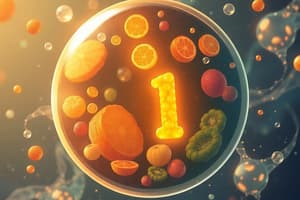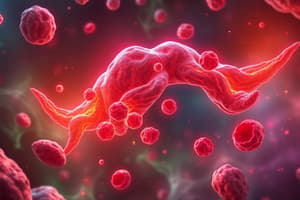Podcast
Questions and Answers
Which of the following cellular characteristics is most critical for a normal stem cell to be susceptible to malignant transformation?
Which of the following cellular characteristics is most critical for a normal stem cell to be susceptible to malignant transformation?
- Intrinsic self-renewal capability. (correct)
- Short lifespan in the absence of specific growth factors.
- Inability to differentiate into multiple cell lineages.
- Limited proliferative capacity.
A patient presents with macrocytic anemia. Initial testing reveals a normal serum folate level but an elevated serum homocysteine level. Which of the following is the MOST likely next step in the diagnostic workup?
A patient presents with macrocytic anemia. Initial testing reveals a normal serum folate level but an elevated serum homocysteine level. Which of the following is the MOST likely next step in the diagnostic workup?
- Perform a bone marrow biopsy to rule out myelodysplastic syndrome.
- Order a serum cobalamin (Vitamin B12) assay. (correct)
- Prescribe erythropoietin-stimulating agents to increase red blood cell production.
- Initiate treatment with folic acid supplementation.
A patient with suspected cobalamin deficiency has already had blood samples taken for cobalamin and folate assays and a bone marrow biopsy performed. They are severely ill upon entering the hospital and waiting for the results. What is the MOST appropriate next step in management?
A patient with suspected cobalamin deficiency has already had blood samples taken for cobalamin and folate assays and a bone marrow biopsy performed. They are severely ill upon entering the hospital and waiting for the results. What is the MOST appropriate next step in management?
- Withhold treatment until lab results are finalized to avoid masking the diagnosis.
- Administer both cobalamin and folate in large doses while awaiting lab results. (correct)
- Administer only folate in large doses while awaiting lab results.
- Administer only cobalamin in large doses while awaiting lab results.
Why is transfusion generally inadvisable for treating cobalamin deficiency?
Why is transfusion generally inadvisable for treating cobalamin deficiency?
A patient with known chronic kidney disease is found to have an elevated serum homocysteine level. Which of the following is the MOST likely cause of the elevated homocysteine in this patient?
A patient with known chronic kidney disease is found to have an elevated serum homocysteine level. Which of the following is the MOST likely cause of the elevated homocysteine in this patient?
Which of the following conditions is LEAST likely to be associated with elevated serum homocysteine levels?
Which of the following conditions is LEAST likely to be associated with elevated serum homocysteine levels?
A patient with macrocytic anemia is being evaluated for cobalamin deficiency. Their serum cobalamin level is borderline low. Which of the following tests would be MOST helpful in confirming cobalamin deficiency?
A patient with macrocytic anemia is being evaluated for cobalamin deficiency. Their serum cobalamin level is borderline low. Which of the following tests would be MOST helpful in confirming cobalamin deficiency?
A patient with heart failure and severe anemia secondary to cobalamin deficiency requires a blood transfusion. What is the MOST appropriate approach to blood transfusion in this scenario?
A patient with heart failure and severe anemia secondary to cobalamin deficiency requires a blood transfusion. What is the MOST appropriate approach to blood transfusion in this scenario?
A patient with Glucose-6-Phosphate Dehydrogenase (G6PD) deficiency is prescribed a medication. Which of the following medications would pose the highest risk of causing a severe exacerbation of hemolytic anemia?
A patient with Glucose-6-Phosphate Dehydrogenase (G6PD) deficiency is prescribed a medication. Which of the following medications would pose the highest risk of causing a severe exacerbation of hemolytic anemia?
A patient with a history of neonatal jaundice (NNJ) and splenomegaly presents with normo-macrocytic anemia and increased bilirubin and LDH levels. Which condition is most likely?
A patient with a history of neonatal jaundice (NNJ) and splenomegaly presents with normo-macrocytic anemia and increased bilirubin and LDH levels. Which condition is most likely?
A patient with a confirmed glycolytic pathway enzyme deficiency presents with variable anemia severity since birth. What morphological abnormality would be expected in the red cells?
A patient with a confirmed glycolytic pathway enzyme deficiency presents with variable anemia severity since birth. What morphological abnormality would be expected in the red cells?
A patient with a history of G6PD deficiency is experiencing an acute hemolytic crisis. Which laboratory finding is LEAST likely to be observed?
A patient with a history of G6PD deficiency is experiencing an acute hemolytic crisis. Which laboratory finding is LEAST likely to be observed?
A researcher is investigating the metabolic pathways in erythrocytes. Which molecule is crucial for maintaining sufficient reductive potential within red cells, thereby protecting them from oxidative damage?
A researcher is investigating the metabolic pathways in erythrocytes. Which molecule is crucial for maintaining sufficient reductive potential within red cells, thereby protecting them from oxidative damage?
A patient is diagnosed with overhydrated stomatocytosis (OHS). Which set of laboratory values is most likely to be observed in this patient?
A patient is diagnosed with overhydrated stomatocytosis (OHS). Which set of laboratory values is most likely to be observed in this patient?
A patient who is diagnosed with congenital nonspherocytic hemolytic anemia (CNSHA) due to G6PD deficiency has increased susceptibility to bacterial infections. What is the primary reason for this increased risk?
A patient who is diagnosed with congenital nonspherocytic hemolytic anemia (CNSHA) due to G6PD deficiency has increased susceptibility to bacterial infections. What is the primary reason for this increased risk?
A patient presents with chronic hemolytic anemia secondary to a red cell enzyme defect. Splenectomy is being considered as a treatment option. In which condition is splenectomy most likely to provide significant benefit?
A patient presents with chronic hemolytic anemia secondary to a red cell enzyme defect. Splenectomy is being considered as a treatment option. In which condition is splenectomy most likely to provide significant benefit?
A patient with G6PD deficiency is prescribed with Phenazopyridine to relieve UTI symptoms. What is the most likely mechanism that would explain the adverse effect of the drug if the patient develops hemolytic anemia?
A patient with G6PD deficiency is prescribed with Phenazopyridine to relieve UTI symptoms. What is the most likely mechanism that would explain the adverse effect of the drug if the patient develops hemolytic anemia?
A patient with chronic hemolysis is suspected of having a red cell enzyme defect. Which of the following findings would be most suggestive of a glycolytic pathway enzyme deficiency rather than G6PD deficiency?
A patient with chronic hemolysis is suspected of having a red cell enzyme defect. Which of the following findings would be most suggestive of a glycolytic pathway enzyme deficiency rather than G6PD deficiency?
Why is supplemental folic acid recommended before and during pregnancy, even in countries with food fortification programs?
Why is supplemental folic acid recommended before and during pregnancy, even in countries with food fortification programs?
A patient with pernicious anemia (PA) has difficulty adhering to a strict injection schedule for vitamin B12 replacement. Which of the following would be the MOST appropriate alternative maintenance therapy, assuming no bleeding tendencies?
A patient with pernicious anemia (PA) has difficulty adhering to a strict injection schedule for vitamin B12 replacement. Which of the following would be the MOST appropriate alternative maintenance therapy, assuming no bleeding tendencies?
A clinician encounters a patient with subnormal serum vitamin B12 levels, normal MCV, no hypersegmentation of neutrophils, and a negative IF antibody test. What is the MOST appropriate next diagnostic step?
A clinician encounters a patient with subnormal serum vitamin B12 levels, normal MCV, no hypersegmentation of neutrophils, and a negative IF antibody test. What is the MOST appropriate next diagnostic step?
Patients with food-cobalamin malabsorption may benefit from oral B12 therapy. Which of the following dosages represents an appropriate approach?
Patients with food-cobalamin malabsorption may benefit from oral B12 therapy. Which of the following dosages represents an appropriate approach?
Which of the following statements BEST reflects the conversion of folic acid after ingestion, considering the context of food fortification?
Which of the following statements BEST reflects the conversion of folic acid after ingestion, considering the context of food fortification?
In cases of suspected cobalamin deficiency, when homocysteine and MMA measurements are unavailable, what is the recommended next step, assuming normal gastrointestinal function?
In cases of suspected cobalamin deficiency, when homocysteine and MMA measurements are unavailable, what is the recommended next step, assuming normal gastrointestinal function?
What is the recommended daily folic acid dose for women with a history of prior fetus with an NTD, when pregnancy is contemplated and throughout the subsequent pregnancy?
What is the recommended daily folic acid dose for women with a history of prior fetus with an NTD, when pregnancy is contemplated and throughout the subsequent pregnancy?
In the context of red cell aging and removal, what process is enhanced by the clustering of band 3 molecules and the binding of hemichromes?
In the context of red cell aging and removal, what process is enhanced by the clustering of band 3 molecules and the binding of hemichromes?
What is a common consequence of increased red cell turnover, especially in individuals with recurrent or persistent hemolysis?
What is a common consequence of increased red cell turnover, especially in individuals with recurrent or persistent hemolysis?
In cases of hereditary hemolytic anemia, what condition may develop due to considerable hemolysis taking place in the spleen?
In cases of hereditary hemolytic anemia, what condition may develop due to considerable hemolysis taking place in the spleen?
What is the primary mechanism by which senescent red cells are targeted for removal from circulation?
What is the primary mechanism by which senescent red cells are targeted for removal from circulation?
Why do red cells have a limited range of responses to metabolic stress?
Why do red cells have a limited range of responses to metabolic stress?
What supplementation should be routinely administered to the smallest premature babies during the first 6 weeks of life because of the high risk of deficiency?
What supplementation should be routinely administered to the smallest premature babies during the first 6 weeks of life because of the high risk of deficiency?
If hemolysis is recurrent or persistent, what is one of the significant consequences related to iron metabolism?
If hemolysis is recurrent or persistent, what is one of the significant consequences related to iron metabolism?
What is the likely cause of some cases of Megaloblastic anemia?
What is the likely cause of some cases of Megaloblastic anemia?
In paroxysmal nocturnal hemoglobinuria (PNH), what is the primary mechanism leading to intravascular hemolysis?
In paroxysmal nocturnal hemoglobinuria (PNH), what is the primary mechanism leading to intravascular hemolysis?
A patient presents with acute intravascular hemolysis following a blood transfusion. Initial investigations reveal ABO incompatibility. Which of the following is the most appropriate next step?
A patient presents with acute intravascular hemolysis following a blood transfusion. Initial investigations reveal ABO incompatibility. Which of the following is the most appropriate next step?
Which condition is characterized by red cell fragmentation as a primary mechanism of intravascular hemolysis?
Which condition is characterized by red cell fragmentation as a primary mechanism of intravascular hemolysis?
A patient develops acute intravascular hemolysis after consuming a large quantity of fava beans. Which of the following tests would be most appropriate to investigate the underlying cause?
A patient develops acute intravascular hemolysis after consuming a large quantity of fava beans. Which of the following tests would be most appropriate to investigate the underlying cause?
What is the underlying mechanism of hemolysis in March hemoglobinuria?
What is the underlying mechanism of hemolysis in March hemoglobinuria?
A patient presents with acute intravascular hemolysis following a recent viral infection. The Donath-Landsteiner antibody test is positive. Which condition is most likely?
A patient presents with acute intravascular hemolysis following a recent viral infection. The Donath-Landsteiner antibody test is positive. Which condition is most likely?
Which of the following is the most common cause of intravascular hemolysis due to mismatched blood transfusion?
Which of the following is the most common cause of intravascular hemolysis due to mismatched blood transfusion?
A patient with a prosthetic heart valve develops intravascular hemolysis. What is the most likely mechanism contributing to this?
A patient with a prosthetic heart valve develops intravascular hemolysis. What is the most likely mechanism contributing to this?
In septicemia caused by Clostridium perfringens, what is the primary mechanism of intravascular hemolysis?
In septicemia caused by Clostridium perfringens, what is the primary mechanism of intravascular hemolysis?
Which diagnostic procedure is most appropriate for confirming Paroxysmal nocturnal hemoglobinuria (PNH)?
Which diagnostic procedure is most appropriate for confirming Paroxysmal nocturnal hemoglobinuria (PNH)?
Flashcards
Cancer Development
Cancer Development
Cancer is a multistep process requiring multiple genetic events.
Stem Cell Properties
Stem Cell Properties
Normal stem cells can persist and self-renew, aiding transformation to cancer.
Anemia Types
Anemia Types
Anemia can be normocytic and normochromic with low reticulocyte response.
Cobalamin Deficiency
Cobalamin Deficiency
Signup and view all the flashcards
Reticulocyte Index
Reticulocyte Index
Signup and view all the flashcards
Serum Homocysteine
Serum Homocysteine
Signup and view all the flashcards
Chronic Conditions
Chronic Conditions
Signup and view all the flashcards
Transfusion Guidelines
Transfusion Guidelines
Signup and view all the flashcards
NADPH
NADPH
Signup and view all the flashcards
Overhydrated Stomatocytosis (OHS)
Overhydrated Stomatocytosis (OHS)
Signup and view all the flashcards
Macrocytic Anemia
Macrocytic Anemia
Signup and view all the flashcards
Hemolysis
Hemolysis
Signup and view all the flashcards
Basophilic Stippling
Basophilic Stippling
Signup and view all the flashcards
G6PD Deficiency
G6PD Deficiency
Signup and view all the flashcards
Normo-Macrocytic Anemia
Normo-Macrocytic Anemia
Signup and view all the flashcards
Bilirubin
Bilirubin
Signup and view all the flashcards
Transfusion Dependent Anemia
Transfusion Dependent Anemia
Signup and view all the flashcards
Splenectomy
Splenectomy
Signup and view all the flashcards
Cobalamin Absorption
Cobalamin Absorption
Signup and view all the flashcards
Folic Acid Fortification
Folic Acid Fortification
Signup and view all the flashcards
Sublingual Therapy
Sublingual Therapy
Signup and view all the flashcards
Importance of Folic Acid
Importance of Folic Acid
Signup and view all the flashcards
Parenteral Therapy Preference
Parenteral Therapy Preference
Signup and view all the flashcards
Vitamin B12 Injections
Vitamin B12 Injections
Signup and view all the flashcards
Folate Deficiency
Folate Deficiency
Signup and view all the flashcards
Homocysteine Measurements
Homocysteine Measurements
Signup and view all the flashcards
Antibody Recognition
Antibody Recognition
Signup and view all the flashcards
Erythropoietic Factors
Erythropoietic Factors
Signup and view all the flashcards
Gallstones Formation
Gallstones Formation
Signup and view all the flashcards
Hemolysis Consequences
Hemolysis Consequences
Signup and view all the flashcards
Macrophages Role
Macrophages Role
Signup and view all the flashcards
Iron Recycling
Iron Recycling
Signup and view all the flashcards
Red Cell Turnover
Red Cell Turnover
Signup and view all the flashcards
Intravascular Hemolysis
Intravascular Hemolysis
Signup and view all the flashcards
ABO Incompatibility
ABO Incompatibility
Signup and view all the flashcards
Paroxysmal Nocturnal Hemoglobinuria (PNH)
Paroxysmal Nocturnal Hemoglobinuria (PNH)
Signup and view all the flashcards
Complement-mediated destruction
Complement-mediated destruction
Signup and view all the flashcards
Paroxysmal Cold Hemoglobinuria (PCH)
Paroxysmal Cold Hemoglobinuria (PCH)
Signup and view all the flashcards
Septicemia
Septicemia
Signup and view all the flashcards
Microangiopathic Hemolytic Anemia
Microangiopathic Hemolytic Anemia
Signup and view all the flashcards
March Hemoglobinuria
March Hemoglobinuria
Signup and view all the flashcards
Favism
Favism
Signup and view all the flashcards
Donath-Landsteiner Antibody Test
Donath-Landsteiner Antibody Test
Signup and view all the flashcards
Study Notes
Megaloblastic Anemias
- Megaloblastic anemias are a group of disorders characterized by distinctive morphologic appearances of developing red blood cells in the bone marrow.
- The bone marrow is hypercellular in these disorders.
- The cause is often a deficiency of cobalamin or folate; however, it can be genetic or acquired abnormalities affecting DNA synthesis.
- Cobalamin (vitamin B12) is vital for cellular function.
- It exists in several forms; the 2-deoxyadenosyl (ado) form is in mitochondria; methylcobalamin is in the cytoplasm.
- It's a cofactor for L-methylmalonyl coenzyme A (CoA) mutase and methionine synthase.
- Dietary sources of cobalamin include meat, fish, and dairy products.
- There's no regulated pathway in the body for cobalamin excretion.
- Absorption occurs in the ileum, facilitated by gastric intrinsic factor (IF).
- The IF-cobalamin complex attaches to cubilin receptors found in the ileal cells, where the IF is destroyed.
- Two main transport proteins for cobalamin are found in the plasma, transcobalamin I and II.
- Folate is essential for many metabolic reactions, including single-carbon unit transfers in DNA/RNA synthesis.
- Folate is found in leafy greens, liver, and yeast.
- Folate polyglutamates (70-90% of natural folate) are absorbed less effectively than monoglutamates.
- Absorption and conversion to 5-methyl-THF occur in the small intestine.
- 5-MTHF is the active form in the blood.
- Folate is transported in the blood via albumin and folate-binding proteins.
Vitamin Deficiencies and Anemia
- Vitamin deficiencies can cause conditions such as macrocytosis, which refers to larger than normal red blood cells.
Clinical features of megaloblastic anemia
- Common symptoms of cobalamin and folate deficiency include anorexia, weight loss, diarrhea, or constipation.
- Glossitis (inflammation of the tongue), angular cheilosis (inflammation at the corners of the mouth), and jaundice can also occur.
- Thrombocytopenia may lead to bruising in severe cases.
- Often, neurological problems result, stemming from the body's inability to produce myelin.
Studying That Suits You
Use AI to generate personalized quizzes and flashcards to suit your learning preferences.



